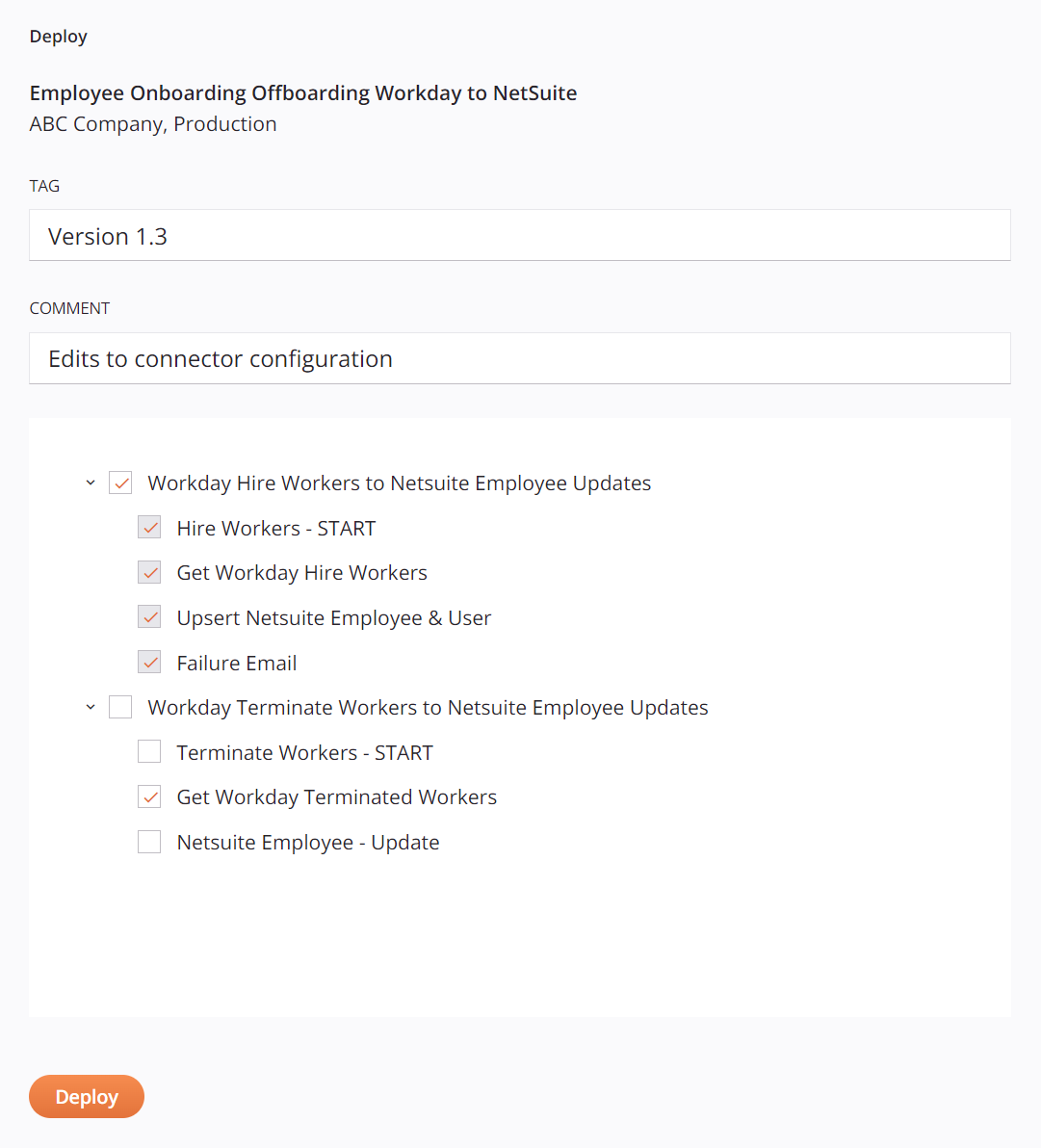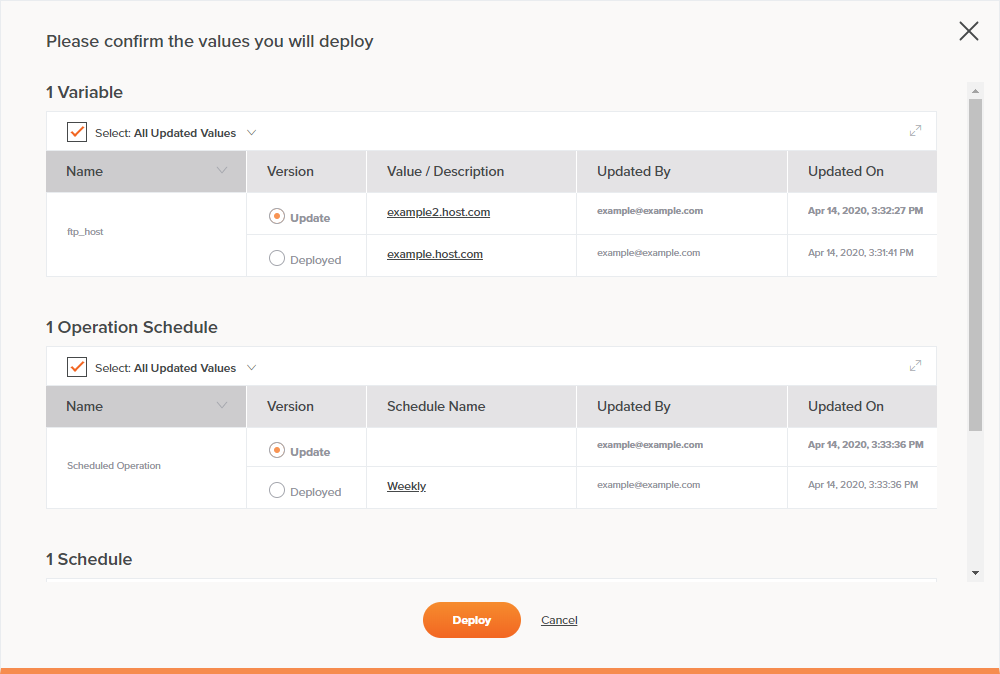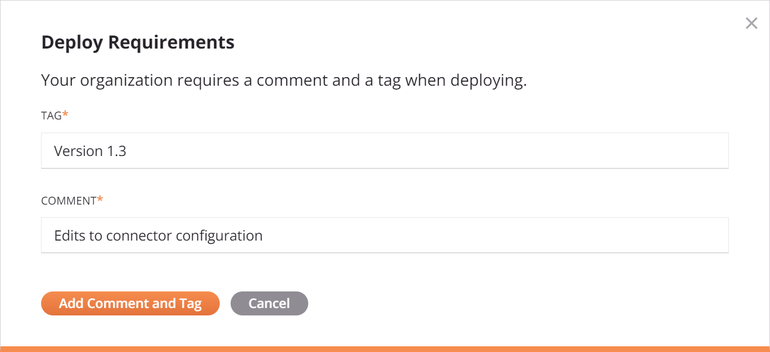Project deployment¶
Introduction¶
This page describes how to deploy projects, workflows, or operations to the Harmony cloud. Once an operation and its dependencies are deployed, those operations can be executed (see Operation deployment and execution).
Deploy¶
There are two options for project deployment: deploying directly and configuring a deploy:
- Deploy: This option refers to direct deployment of all operations used by a project's workflows. Selecting this option immediately deploys the project or reports validation errors preventing deployment.
- Configurable Deploy: This option refers to deployment of selected workflows and operations. Selecting this option opens a deployment configuration screen where you can choose which workflows and operations to deploy.
Additional screens may be presented under certain circumstances:
- Select schedules and project variables: If there are any project variables or schedules being deployed that have already been deployed in the Harmony cloud, a screen presents you with options for selecting which values to use.
- Add tags and comments: If project-level deployment settings have been configured to require a tag and/or a comment on deploying, a dialog is presented when initiating a deploy to enter the required tag and/or comment. These fields are also provided directly on the configurable deploy screen.
You can continue working during a deploy. Informative messages in the top right corner of the screen indicate when a deploy is in progress and and when a deploy has been completed.
Note
When renaming a project that has previously been deployed, the new project name is automatically deployed and updated in Harmony. No other part of the project besides the name is automatically deployed.
Deploy¶
The Deploy option to deploy all operations used by a project's workflows is accessible from these locations:
- The project toolbar (see Project actions menu in Project toolbar).
- The design canvas (see Deploy/migrate actions menu in Design canvas).
On selecting Deploy, a deploy is immediately attempted for all operations used by a project's workflows. In order for the deploy to succeed, all workflows and operations in the project must be valid. Unused components that are not used in the logical flow of a project workflow are not deployed.
If any workflows or operations are invalid, the specific validation error(s) are provided in a dialog. For documentation on each error and how to resolve it, refer to Workflow validity and Operation validity.
Configurable deploy¶
The Configurable Deploy option to configure a deploy for selected workflows or operations is accessible from these locations:
- The project toolbar (see Project actions menu in Project toolbar).
- The design canvas (see Deploy/migrate actions menu in Design canvas).
On selecting Configurable Deploy, a deployment configuration screen opens where you can define a tag and comment and choose which workflows and/or operations to deploy:

-
Project Information: Along the top of the screen, the name of the project is provided, below which is the Harmony organization and environment where the project exists.
-
Tag: Enter a tag to be used to label the deploy event. The tag will be displayed as a label on the deploy event and recorded in the deploy details accessible from the project history. This field may be required depending on project-level deployment settings.
-
Comment: Enter a comment to be used to describe the deploy event. The comment will be recorded in the deploy details accessible from the project history. This field may be required depending on project-level deployment settings.
-
Select Workflows and Operations: Select the workflows and/or operations to deploy. By default, none are selected. You must select at least one item to enable the Deploy button.
When you select a workflow or operation, any other workflow or operation dependencies are also selected and cannot be cleared.
To collapse or expand workflows and operations, use the disclosure triangles

 displayed to the left of the workflow or operation name.
displayed to the left of the workflow or operation name.The names of invalid workflows or operations appear in the color red and italics. Selected items must be valid to enable the Deploy button.
-
Deploy: Click to deploy selected workflows and/or operations.
Select schedules and project variables¶
If there are any project variables or schedules being deployed that have already been deployed in the Harmony cloud, a screen presents you with options for selecting which values to use. This allows you to keep or override values set outside of Cloud Studio, such as through the Management Console Projects page.

Each category, of variables, operation schedules, and schedules, is covered below. Once you have made your selections, click Deploy to continue with the deploy or configurable deploy as configured, or Cancel to return to the previous screen without deploying.
Variables¶
This table includes any project variables that have a different value or description from those already deployed in the Harmony cloud:

-
Select: When selected, this checkbox is used to toggle the selections in the Version column. When cleared, the option selected in the dropdown has no effect on the table. These dropdown options are available:
- All Updated Values: When the checkbox and this option are selected, all selections in the Version column are toggled to Update.
- All Deployed Values: When the checkbox and this option are selected, all selections in the Version column are toggled to Deployed.
-
Popout: Click the popout icon
 to show only the table of variables, hiding any operation schedules and schedules. After opening this view, click the return icon
to show only the table of variables, hiding any operation schedules and schedules. After opening this view, click the return icon  to come back to the full screen.
to come back to the full screen. -
Name: The names of any project variables that have a different value or description from those already deployed in the Harmony cloud are listed.
This doesn't include project variables that are already deployed but have the same value and description as that in the Cloud Studio project, or project variables that are only within the Cloud Studio project and haven't yet been deployed.
Tip
A project variable may have already been deployed in the Harmony cloud if you previously deployed the project or if you edited the project variable through the Management Console Projects page.
-
Version: Select between the two versions of the project variable:
-
Update: Use the value and description of the project variable that is present in the Cloud Studio project. This will override the value and description currently deployed in the Harmony cloud. Once deployed, the project variable value and description in Cloud Studio and in the Harmony cloud will be in sync.
-
Deployed: Use the value and description of the project variable that is currently deployed in the Harmony cloud.
Warning
Once deployed, the project variable value and description in Cloud Studio will not be updated. To continue using the version deployed in the Harmony cloud, you will need to make this selection each time you deploy the Cloud Studio project, or you can update the project variable in Cloud Studio to match that deployed in the Harmony cloud to prevent it from appearing on this screen.
-
-
Value / Description: The value of the project variable is listed. If the value is configured to be hidden in the UI, asterisks that mask the value are displayed. Additional details can be viewed by hovering over the cell:
- Value: The value of the project variable is listed. If the value is configured to be hidden in the UI, asterisks that mask the value are displayed.
- Description: The description of the project variable is listed.
-
Updated By: The Harmony username of the user who last updated the project variable component is listed. The update may have been made in Cloud Studio or the Management Console.
-
Updated On: The date and time that the project variable component was last updated, reported in your local browser time zone.
Operation schedules¶
This table includes any operations that have a difference in applied schedules compared with those already deployed in the Harmony cloud:

-
Select: When selected, this checkbox is used to toggle the selections in the Version column. When cleared, the option selected in the dropdown has no effect on the table. These dropdown options are available:
- All Updated Values: When the checkbox and this option are selected, all selections in the Version column are toggled to Update.
- All Deployed Values: When the checkbox and this option are selected, all selections in the Version column are toggled to Deployed.
-
Popout: Click the popout icon
 to show only the table of operation schedules, hiding any variables and schedules. After opening this view, click the return icon
to show only the table of operation schedules, hiding any variables and schedules. After opening this view, click the return icon  to come back to the full screen.
to come back to the full screen. -
Name: The names of any operations that have a difference in applied schedules compared with those already deployed in the Harmony cloud are listed.
This doesn't include operations that have applied schedules that are already deployed but are the same in the Cloud Studio project, or applied schedules that are only within the Cloud Studio project and haven't yet been deployed.
This doesn't consider whether the schedule has been enabled or disabled from the Management Console, as that isn't a setting that can be toggled in Cloud Studio.
Tip
A schedule applied on an operation may have already been deployed in the Harmony cloud if you previously deployed the project or if you applied or removed a schedule from an operation through the Management Console Projects page.
-
Version: Select between the two versions of the operation that has schedule applied:
-
Update: Use the schedule that is applied on the operation in the Cloud Studio project. This will override the applied schedule setting currently deployed in the Harmony cloud. Once deployed, the applied schedule in Cloud Studio and in the Harmony cloud will be in sync.
-
Deployed: Use the schedule that is applied on the operation that is currently deployed in the Harmony cloud.
Warning
Once deployed, the operation to which the schedule is applied in Cloud Studio will not be updated. To continue using the version deployed in the Harmony cloud, you will need to make this selection each time you deploy the Cloud Studio project, or you can update the applied schedule in Cloud Studio to match that deployed in the Harmony cloud to prevent it from appearing on this screen.
-
-
Schedule Name: The name of the schedule applied on the operation is listed. If the operation doesn't have an applied schedule, this cell is empty. Additional details can be viewed by hovering over the cell:
- Name: The name of the schedule applied on the operation.
- Occurs: The days on which the schedule is configured to run.
- Frequency: The times at which the schedule is configured to run. The time zone is that of the agent running the operation.
- Start Date: The date on which the schedule is configured to start.
- End Date: The date on which the schedule is configured to end.
-
Updated By: The Harmony username of the user who last updated the applied schedule. The update may have been made in Cloud Studio or the Management Console.
-
Updated On: The date and time that the applied schedule was last updated, reported in your local browser time zone.
Schedules¶
This table includes any operation schedules that have a different configuration from those already deployed in the Harmony cloud. Schedules in this category are listed regardless of whether they are applied on any operations:

-
Select: When selected, this checkbox is used to toggle the selections in the Version column. When cleared, the option selected in the dropdown has no effect on the table. These dropdown options are available:
- All Updated Values: When the checkbox and this option are selected, all selections in the Version column are toggled to Update.
- All Deployed Values: When the checkbox and this option are selected, all selections in the Version column are toggled to Deployed.
-
Popout: Click the popout icon
 to show only the table of schedules, hiding any variables and operation schedules. After opening this view, click the return icon
to show only the table of schedules, hiding any variables and operation schedules. After opening this view, click the return icon  to come back to the full screen.
to come back to the full screen. -
Name: The names of any schedules that have a different configuration from those already deployed in the Harmony cloud are listed. Schedules in this category are listed regardless of whether they are applied on any operations.
This doesn't include schedules that are already deployed but have the same configuration in the Cloud Studio project, or schedules that are only within the Cloud Studio project and haven't yet been deployed.
Tip
A schedule may have already been deployed in the Harmony cloud if you previously deployed the project or if you created, edited, or deleted a schedule through the Management Console Projects page.
-
Version: Select between the two versions of the schedule:
-
Update: Use the schedule configuration that is present in the Cloud Studio project. This will override the configuration currently deployed in the Harmony cloud. Once deployed, the schedule configuration in Cloud Studio and in the Harmony cloud will be in sync.
-
Deployed: Use the schedule configuration that is currently deployed in the Harmony cloud.
Warning
Once deployed, the schedule configuration in Cloud Studio will not be updated. To continue using the version deployed in the Harmony cloud, you will need to make this selection each time you deploy the Cloud Studio project, or you can update the schedule configuration in Cloud Studio to match that deployed in the Harmony cloud to prevent it from appearing on this screen.
-
-
Value: A summary of the schedule configuration is listed. Additional details can be viewed by hovering over the cell:
- Name: The name of the schedule.
- Occurs: The days on which the schedule is configured to run.
- Frequency: The times at which the schedule is configured to run. The time zone is that of the agent running the operation.
- Start Date: The date on which the schedule is configured to start.
- End Date: The date on which the schedule is configured to end.
-
Updated By: The Harmony username of the user who last updated the schedule is listed. The update may have been made in Cloud Studio or the Management Console.
-
Updated On: The date and time that the schedule was last updated, reported in your local browser time zone.
Add tags and comments¶
Deployment requirements can be configured for each project during project creation and configuration.
If project-level deployment settings have been configured to require a tag and/or a comment on deploying, a dialog is presented when initiating a deploy to enter the required tag and/or comment. These fields are also provided directly on the configurable deploy screen.

- Tag: Enter a tag to be used to label the deploy event. The tag will be displayed as a label on the deploy event and recorded in the deploy details accessible from the project history.
- Comment: Enter a comment to be used to describe the deploy event. The comment will be recorded in the deploy details accessible from the project history.
- Add Comment and Tag: Click to add the tag, comment, or both, and continue with the project deploy.
- Cancel: Click to close the dialog and return to the previous screen without deploying.